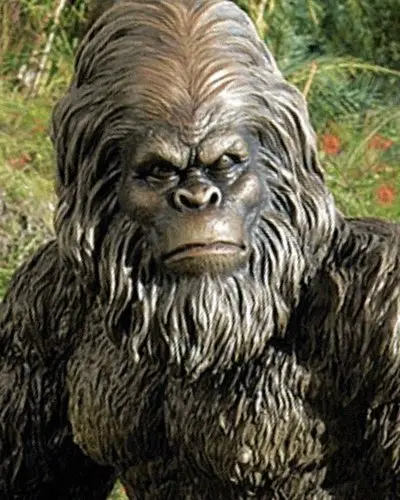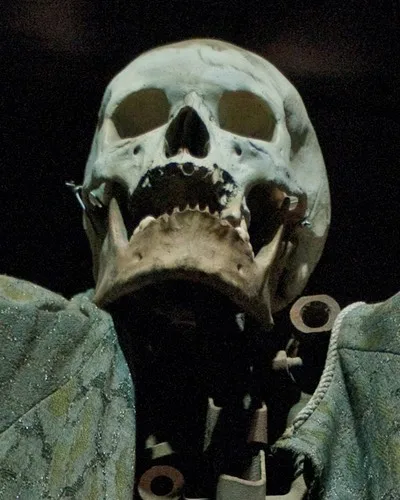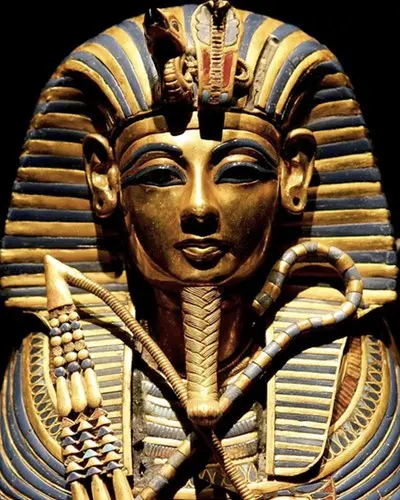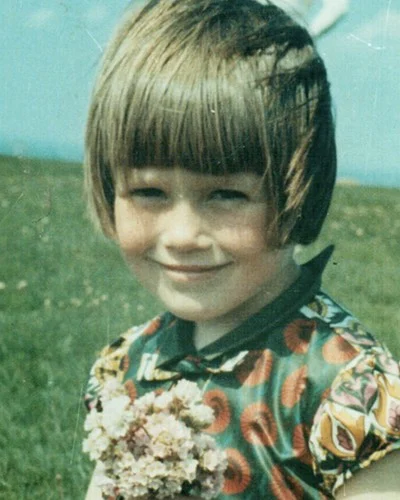The Legend of Boggy Creek was a sensation in America’s drive in theatres in 1972. But what set this low budget B picture apart from countless other schlocky monster movies was a then unique novelty - it was all true.
At least that's what it's creator Charles B. Pierce claimed. His documentary style film would probably be forgotten today if it hadn't purported to depict a series of incredible real events that had recently taken place in Fouke, a small rural town in Arkansas.
People had always seen strange things stalking the shadows around Boggy Creek. The lonely, isolated woodland holds many dark secrets and in May, 1971, a local resident was about to come face to face with one of them.
When reporter Jim Powell first got the call, he could hardly of known he was about to stumble upon the biggest story of his life. Powell had been tipped off that a local resident, Bobby Ford, was been treated at the St. Michael Hospital in Texarkana because he had been attacked by nothing less than a monster.
Ford was at his brother’s house, sometime around midnight, when it struck. The huge, black, Bigfoot-like creature attacked him in the yard, grabbing him by the shoulder and pinning him to the ground. Ford managed to struggle free from the beast's grasp and escape with just scratches and a case of shock.
According to the Fords, their first encounter with the mysterious animal occurred earlier that evening, when Ford’s wife Elizabeth had seen a 7ft tall black figure, eyes as red as hot coal, lurking on the porch outside of her window. Bobby and his brother Don, returning from a hunting trip, managed to get a few shots in before the creature retreated back into the woods.
Investigators later examined the Ford property and failed to find any traces of blood, but did observe scratches and damage to the house, as well as some three-toed footprints in the back yard.
The Ford encounter was only the first of a spate of similar sightings in Southern Arkansas that summer, stretching from the Sulphur River Bottoms to the town of Fouke itself. As news of the monster began to spread, the local newspapers were inundated with more extraordinary tales about what had quickly become dubbed the Fouke Monster.
These stories did not go unnoticed by Charles B. Pierce, an Arkansas advertising executive and commercials director keen to break into features. Sensing that the sensational stories coming out of the area would make a terrific horror movie, Pierce got together a shoestring budget of $160,000 and quickly filmed The Legend of Boggy Creek in and around Fouke in the summer of 1972.
The film was a massive hit and became an instant cult classic, grossing a staggering $25m (over 100 times its budget) and catapulting the monster to international fame. While hokey and ramshackle by today’s standards, the film was influential for its pioneering use of a pseudo-documentary style which gave it a sense of gritty realism rare at the time.
Boggy Creek’s mixture of talking heads and reenactments can be seen in everything from paranormal TV documentaries like In Search Of... to similar breakout horror film The Blair Witch Project, which was directly inspired by Pierce’s movie.
It also led to a rash of copycat films such as Creature from the Black Lake and cameo appearances by Bigfoot-like creatures in TV shows, include one memorably unlikely encounter with the Six Million Dollar Man.
The Legend of Boggy Creek eschews professional actors, instead relying on real Fouke residents who had personally seen the monster, recounting their experiences. Whilst the film is entirely based on real reports, it's hard not to come away with the impression that Pierce embellished some of the incidents to create a better movie.
Whatever the case, it remains an affecting and memorable film, living on in the public consciousness through countless late night cable TV showings and modern day remakes, the latest of which, 2010’s ‘Boggy Creek’ bares little or no resemblance to the original source material.
Pierce’s film aside, what makes the Fouke monster unusual in Bigfoot lore is the sheer number of sightings in such a short period of time, making it hard to dismiss as the usual overactive imaginations or misidentified wild animals. Could so many of these witnesses have made a mistake, or were the residents of Fouke engaged in a giant collective hoax?
Ominously, there are even hints of far older sightings, some dating back to the 1940s and earlier, indicating whatever was stalking the swamps of the Sulphur River was not new or even a single creature, but a population of them.
And it wasn't just eyewitness sightings, footprints were also found and cast, a set of which are now on display at Fouke’s famous Monster Mart. These footprints amongst others show the creature to be three-toed, unusual amongst Bigfoot sightings.
If the monster was a real beast, was it more akin to a sloth than the traditional, tall, human like Sasquatch? And would such a creature even be viable in the swamps and woodland of rural Arkansas?
Despite the impressive number of sightings, and the foot casts, tangible physical evidence of the Fouke monster remains elusive. No photographs have yet emerged, and no verified traces of hair, scat or bones have ever been found.
Cryptids like this are notoriously shy, rarely leaving behind any definitive evidence of their existence. But with so many sightings, many from experienced hunters, could the swamp stalker of Boggy Creek really exist?
Evidence For
The early sightings
Perhaps due to the film, the Fouke monster is often written off as a short lived craze, a self-fueling piece of mass hysteria driven by overactive imaginations. But a look back through the local history books reveals strange creatures had been seen long before The Legend of Boggy Creek hit theatres in 1972.
As early as the 1850 tales from hunters of ‘wild men’ attacking cattle and stealing food were quite common in Arkansas. One improbable story, published in the Louisiana Caddo Gazette in 1856, even had the beast in question stealing a hunter's horse and riding off with it.
But the first recognisable sighting of our monster comes from way back in 1908, deep in the memory recesses of even the oldest Fouke residents. That year a large dark haired ‘monkey-man’ eerily similar to what would later be christened the Fouke Monster was seen by an 10 year old girl.
Eight years later another black, hairy, man-like beast was spotted in nearby Knight’s Bluff. In 1932 a Jonesville man saw what seemed to be the same monster scratching around on his porch, before it vanished into the woods. A further sighting was reported to Fouke sheriffs in 1946, described as walking like a man but ‘not a man’.
1955 saw a cluster of new sightings around Fouke and Jonesville, including two motorists who saw a hairy, man like creature flitting across the road near their home. Shortly after, the Victoria Advocate reported how one huntsman claimed to have got 15 shots off at a large ‘apeman’ close to nearby Boggy Creek, but apparently missed.
The next spate of sightings occurred in the mid-60s, largely amongst hunters. One typical description had the creature at seven-foot tall with “reddish-brown hair about four inches long all over its body. It stood upright like a man, but had extra-long arms”.
A particularly notable encounter from this time-period was that of Carl Finch, the founder of band Brave Combo, who saw a large hairy bipedal creature late one night whilst driving through the area with his cousin. What was an interesting personal anecdote only took on further significance after Finch saw The Legend of Boggy Creek several years later, and realised he had seen the now famous beast first hand.
These various sightings were intermittent and highly anecdotal, but also persistent and somewhat consistent. For the grizzled old veterans in the sheriff's department the stories of monsters were all too familiar, shrugged off as an amusing local legend. But whatever was out there in the swamps of Boggy Creek it was about to break out and achieve international fame.
The great monster mash of ’71
Despite the plethora of early sightings, it wasn't until the early 1970s that the beast lurking around the dark environs of Fouke started to make national headlines.
Shortly after Bobby Ford’s hospitalization in early May 1971, the previous trickle of monster sightings started to become a torrent. Route 71, a vast 1500 mile long highway that bisects the country north to south and passes through over 300 miles of Arkansas, would play host to many of them.
In mid-May, Mr. D Woods, his wife Wilma Woods and their friend were driving along the road near Boggy Creek when they saw something strange in the headlights. Running across the road in front of the well-respected local residents was a huge hairy ape like creature with long arms and dark hair.
Wilma Woods recounted the story to the Texarkana Daily News the next day. “It was hunched over and running upright. It had long dark hair and looked real large. It was swinging its arms, kind of like a monkey does. I thought my eyes were playing tricks on me, but there it was. My husband turned to me after it crossed the road and asked me if I saw it, too”.
"It was hunched over and running upright. It had long dark hair and looked real large. It was swinging its arms, kind of like a monkey does…"
Shortly after, Fouke gas station owner Willie Smith made an unusual discovery in the soybean field that backed his property. A set of curious three-toed animal prints, alarming in their size, leading away from the garage. These three-toed prints were very similar to the ones found around the Ford property the previous month, indicating they may have had a common perpetrator.
Smith’s find became a local spectacle, with Fouke residents flocking to the field to see the prints. A group of them even saw the monster lurking in the bushes that edged the field, perhaps observing the attention it’s tracks had caused in the local community.
Game warden Carl Galyon was baffled by the casts, as they matched nothing he had ever seen before in the area. The prints even made their way to Dr. Frank Schambagh, an archeology professor at Southern Arkansas University, who somewhat dampened the fervour by suggesting they might be a hoax.
If this was the case, then it would probably entail some degree of collusion between Smith and the Fords, as the prints found at the different properties appeared to have a common source. But whether the prints were genuine or not, the sightings kept coming.
That summer alone, the monster made dozens of further appearances, almost as if it was audition for its forthcoming starring role in The Legend of Boggy Creek.
A red eyed, hairy creature was spotted squatting near the woods adjacent to the homes of several Fouke residents. A child also reported seeing the same thing running into the woods a few nights later. Willie Smith’s soybean field played host to more cameo appearances, with a woman and two men seeing a large 6ft tall hairy creature walking along the road near the field.
One particularly notable sighting involved several campers at nearby Mercer Bayou. A family preparing their boat for a trip out onto the lake heard a piercing howl followed by what they described as a large sasquatch like creature emerging from the woods. Panicked campers ran from the trailers to try and get a shot at the monster but it fled before they could make a hit.
The beast of Boggy Creek was suddenly everywhere, spotted by Fouke residents and out of state tourists alike. Many of these stories were recounted in Charles B Pierce's film, and dozens more were reported in the local papers. Was this some case of mass hysteria, a collective delusion or an elaborate, all consuming local hoax?
If it was a real creature then it remained decidedly elusive. Even when a $1000 bounty was placed on the monster by Little Rock radio station KAAY, the county's finest hunters, wielding packs of hounds, failed to find a trace of it.
Despite this, the reality of the monster had become firmly established in the community; too many people had seen it to simply dismiss it as a figment of overactive imaginations. The sightings would continue to come in for several more years, although by the mid 70s they had decreased substantially in frequency.
But they never truly go away. At least once a year somebody sees a large hairy creature lumbering along the edges of the woods or running down the dark highways at night. As recently as 2016 people are still seeing it, or perhaps the son or grandson of it.
After all, If it was the same beast all these years then it must be very old indeed, if it is even a flesh and blood animal at all. Perhaps, as some believe, the real entity hiding out in the woods and swamps of rural Arkansas is stranger then we can possibly imagine.
Evidence Against
Stranger Things
The aforementioned Dr. Frank Schambagh felt the three-toed footprint casts from Willie Smith’s soybean field could not have been made by an apeman. Anthropologists have never found any kind of hominid or primate, past or present, with anything less than five toes.
Since the monster was almost universally described by witnesses as an ape or apeman, it would rule out the tracks as genuine, unless the beast was an exceptional evolutionary outlier. Likewise the casts made at the Ford house, which also had three toes, appear to contradict what the family claimed to have seen.
Even other Bigfoot and Sasquatch casts made all around the Pacific North West of America always show five toes, making the monster highly unusual in cryptid lore. Only the so called Honey Island Swamp Monster, also described as three-toed, bares a resemblance. Is it just coincidence that this creature is said to reside very close to Fouke in neighbouring Louisiana?
Could the two animals be related, or even one and the same? If so it does not overcome the other objections to the Fouke footprints. The Smith cast shows a foot that is long and thin, around 13 by 4 inches. This is quite unlike any known species of primate, which invariably have wider feet to support their size and weight.
The kind of evenly sized straight toes on the cast are also alien to any species of ape or hominid, who all have splayed, unevenly sized toes. Could the Fouke monster still be a primate, but one exhibiting mutation or injury? It seems unlikely in light of the number of sightings that had the creature running upright like a human.
Beyond the technical objections, scientists rarely value footprint casts too highly as evidence. The casts themselves invariably have uncertain and dubious origins, and cryptozoology has over the years earned a somewhat well deserved reputation for fakery.
Indeed in later years, the design of the footprints found in the area began to evolve to become more conventionally ape-like, which naturally raises the suspicion that this was simply hoaxers becoming more sophisticated in their efforts. It certainly didn’t attest well for the credibility of a real monster, which would have to be exhibiting a now supernatural ability to grow extra toes.
It would be unfair to entirely dismiss the whole Fouke monster phenomena as fakery however; clearly many of the witnesses who saw some kind of strange animal in the area were genuine people. But could the creature so many encountered be a somewhat less fantastical beast?
Where the Wild Things Roam
Bigfoot like creatures are often dismissed by skeptics as misidentified black bears. On many occasions the elusive hard evidence that might finally prove the existence of Bigfoot - scat, hairs, bones, DNA, has turned out to be bear. Could the Fouke monster simply be one of Arkansas’ native black bears?
The black bear is a good fit size wise with most of the descriptions of the Boggy Creek monster. Weighting up to 400 pounds, the bear can rear up on its hind legs and reach heights of 6 or 7ft.
Many of the sightings occurred at night, in the woods or other rural areas. In the circumstances it does not seem out of the question that these often fleeting eyewitness encounters were with bears who appeared in the dark to be somewhat more inexplicable than they actually were.
Proponents of the Fouke monster counter this by arguing that black bears are not particularly common in the area, although this might also be a good explanation of why the sightings are relatively sporadic.
Perhaps more convincing is the number of hunters who claimed to have seen the beast. Most hunters in the Southern states are well familiar with the black bear, could they really have made such an elementary error and risked the ridicule of their friends by claiming to have seen a monster?
There is, however, a total lack of evidence for any other large mammal existing in the area. Nobody has ever produced any bones, hair, scat or even photographs of anything other than a black bear, making it look the most likely suspect in our monster hunt.
This remains the case in all instances of Bigfoot and his lookalikes, big on eyewitness testimony but low on hard evidence. Perhaps if Charles B. Pierce had not made The Legend of Boggy Creek back in 1972, the Fouke monster would be no more famous than the countless other cryptid legends around America, and indeed the world.
From the Siberian Chuchunaa to the Australian Yowie, human beings have been seeing hairy apemen out in the wilderness since we ourselves were hairy apemen. These stories of some long lost cousin of mankind exist in virtually every culture in the world.
Do they represent a real flesh and blood animal, or are they an intangible manifestation of some ancient mythology buried deep in our collective folk memory? All the questions we have about the mysterious creatures, what they are, how they remain so elusive and even if they exist at all will never be answered until we finally meet one face to face.
Perhaps if we ever do so we will discover they have many of the same questions about us.
Did a Bigfoot like monster stalk the marshes of Fouke, Arkansas, in the 1970s? - add your comment below



















